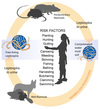Leptospirosis Flashcards
What agent causes leptospirosis?
Bacterial spirochete
-
Leptospirosis interogans
- Autumnalis, Bratislava, Cannicola, Icteriohaemorrhagiae, Pomona
-
Leptospirosis kirshneri
- Grippotyphosa
- Specific serovars are host-adapted to certain reservoir species (all can affect humans)
- PATHOGENIC SEROVARS DO NOT REPLICATE OUTSIDE THE ANIMAL HOST

How is leptospirosis maintained?
Animals
- Can persist in renal tubules without causing any disease
- Excreted in urine
- Evade immune responses
Where (geographically) is leptospirosis more commonly seen?
Enzootic worldwide
- Warm and higher annual rainfall places (Hawaii, west coast, etc.)
- Early fall or summer

What type of environment does leptospirosis thrive in?
- Alkaline soil
- Tropical and semitropical regions

Who is the poster child for leptospirosis (most at risk)?
Adult (4-7 years) males
- Hounds, working and herding breeds (outdoor animals more exposed)

How is leptospirosis transmitted?
- Eliminated by the urine > enter through abraded skin and intact mucous membranes
- Excreted for years (even treated)
- Cats = subclinical

What is the pathogenesis of leptospirosis in dogs?
- Renal tubular infection > acute interstitial nephritis and tubular dysfunction > acute kidney failure
- Mild hepatic necrosis and mild neutrophilic periportal hepatitis > acute liver failure
What are the clinical signs in dogs with leptospirosis?
- Subclinical
- No associated between clinical signs and serovars
-
Clinical signs in 7 days
-
Renal or hepatic failure (usually present with GI signs)*
- PU/PD > oliguria/ anuria
- Dehydration
- V/D, inappetance, lethargy, or abdominal pain
- Icteric
- Acute febrile illness, pulmonary hemorrhage, uveitis, muscle pain, abortion in LA
-
Renal or hepatic failure (usually present with GI signs)*
- May develop chronic renal failure or chronic active hepatitis
- May clear infection in 2-3 weeks

What lab changes can you see in a patient with leptospirosis?
- CBC
- Acute: leukopenia
- Subacute: leukocytosis
- Thrombocytopenia
- Chemistry
-
Increased BUN and creatinine (renal failure) >80-90%
- Cillindruria, pyuria, hematuria, isosthenuria, hyposthenuria
- Increased ALT and ALP (ALP > ALT), increased bilirubin, increased GGT (liver disease)
-
Increased BUN and creatinine (renal failure) >80-90%
- Diffuse interstitial patterns (interstitial lung disease)
How do you diagnose a dog with suspected leptospirosis?
Clinical signs +
-
Detection of antibodies
-
MAT > reacting dilution of serum with live leptospiral serovars and assessment of agglutination
- Problem: exposure only and takes too long
- Active infection:
- MAT titer > 3200
- 4-fold increase in titer over 2 weeks
- Positive IgM ELISA
-
MAT > reacting dilution of serum with live leptospiral serovars and assessment of agglutination
-
Demonstration of organism
- Microscopy (problem with intermittent shedding = false negatives)
-
Culture (before ABCs)
- Tranpsort ASAP (special media)
- Problem: growth is slow and overgrowth issues
-
PCR (early infection
- Problem: can be positive after recovery , disease or carrier
- First 10 days blood, after 10 days urine (send both)
- Detect nucleic acids
How do you treat a dog positive for leptospirosis?
- Fluid therapy (preserve renal function and maintain hydration)
- Antibiotics
- Doxycycline (GI side effects)
- Ampicillin
- First gen. cephalosporins + quinolones controversial
- CRTT or hemodialysis in anuric/ oliguric renal failure ($$$)
- Not much you can do to support hepatic disease
- Oxygen therapy/ mechanical ventilation for pulmonary hemorrhage
What is the prognosis in a dog with leptospirosis?
Survival rates ~80% (conservatively + dialysis)
- Respiratory complications: mortality rate 36-50%
- Successful if BUN and creatinine WNL in 10-14 days
- Regeneration of damaged renal tissues continue over 4 weeks
- ALT and ALP decline faster than bilirubin
- Platelets improve within 1 week
How can leptospirosis be prevented?
- WEAR GLOVES
- Vaccines
- Reduce severity of disease
- Not always necessary
- High risk patients: 4-way lepto product at 12 weeks, 15 weeks, 6 months, 1 year (vaccinate more often)
- Reactogenic vaccine
Is leptospirosis zoonotic (dogs to humans)?
RARE IN HUMANS (get it form drinking dog urine)
- Infection through mucosal contact with water or soil contaminted with urine of infected animals
- Risk: veterinarians, farms, abattoir workers, recreational activities in water
- CAN CAUSE DEATH



